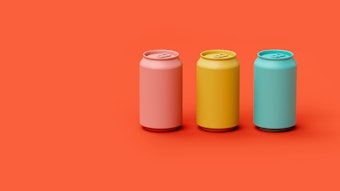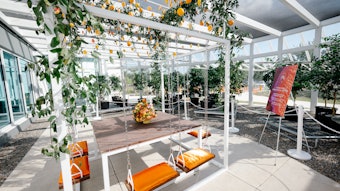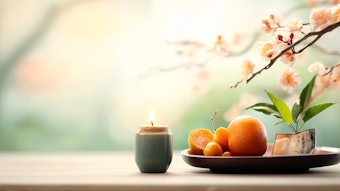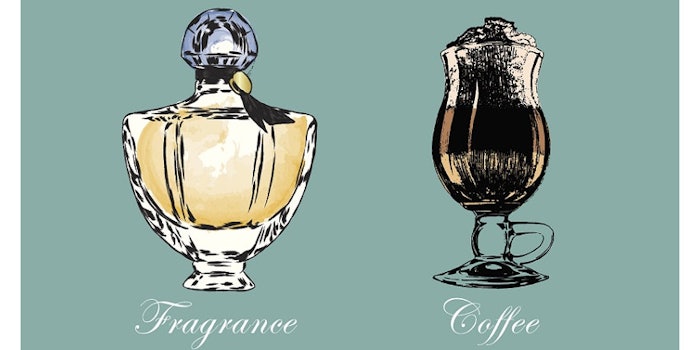
Coffee is so engrained in our daily cultural routines that it’s hard to imagine a world in which the drink is not a beloved essential for so many millions.
Whilst the USA is often associated with chronic coffee drinkers (64% of Americans consume at least a cup a day), it only figures 26th in international consumption, averaging 4.2kg per capita per year (which equates to roughly two cups a day for the average American head)a, b. Figures processed by the International Coffee Organization from 2017 pit Finland as the world’s top coffee consumer with just over 12kg per capita per year (over five cups a day). Places two to eight are all occupied by northern European countries, with North America debuting at number 10, showcasing Canada’s 6.2kg a year average personal intake (just under three cups a day)c.
Black Hearts
The immense popularity of coffee is not due exclusively to its stimulation of the central nervous system - McCafé’s Feelin’ Good Summer Survey 2018, reported by Business Wire, highlighted the emotional potency the coffee experience carries for many drinkers. According to the 1,000 American adults interviewed, almost half (47%) turn to coffee to get a better start to their day, with more than a third (34%) of respondents saying they would prioritize drinking coffee over brushing their teeth if they only had 10 minutes to get ready in the morningd. More than two in five (43%) of Americans would grab an iced or cold coffee if they needed a ‘pick-me-up,’ and 40% of respondents believe summer would be incomplete without iced or cold coffee (pool days won over 54% of the crowd and ice cream trucks 44%). It is a sound assumption that most of these associations were prompted from latte flavor profiles, the milk-dominant drink featuring pronounced caramel and creamy taste layers that is the favorite of 44 of the 50 states (with only New Mexico and Hawaii preferring tea)e.
How did coffee come to occupy such an essential and stirring place in people’s hearts and on their office desks? Is coffee the only product that can achieve what coffee-drinkers seek to satisfy or are there other categories of experience that could quench the emotional roots of coffee? The principle explored in this article is that it’s not really the bean itself that’s driving people into cafés and encouraging sales of domestic coffee machines but the cultural promise of what coffee will give you – its experience, its values and its aspirations based on a history of luxury, intellect and leisure – and that the perfume industry has the opportunity to reposition its offering to more closely resemble coffee culture and normalize olfactory pick-me-ups as indispensable and easily accessible agents for a performance boost, comfort and socializing.
Historically Cool
The highly charged historical ideologies surrounding coffee have undoubtedly been intensified by the arts and crafts revival of the mid 2010s (spawning an explosive renewal of low-budget, high-intensity, highly skilled processes applied to food and drink, furniture, ceramics and anything that’s constructed with the hands) in which unique markings and variations imbued with personal stories are revered over the shadowy, shiny, flawless mechanics of pop-culture megabrandsf. Within this framework, the coffee environment intersects hedonism with health consciousness, venture capitalists with novelists, and snobby connoisseurship with down-to-earth realism.
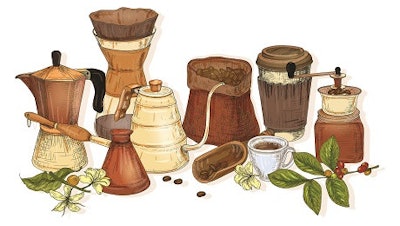
The drink has long-been connoted with subcultures and luxury at the same time. The origin of coffee largely remains a disputed legend, but it is often proposed that Ethiopia, where the plant is native, was the first region to harvest beans for consumptiong. Journalist Katie Kilkenny notes that “the earliest coffee shops came in the mid-16th-century Ottoman Empire … Over the course of the 1500s, rulers and religious leaders denounced coffee as a poor influence that could lead to gambling and improper sexual relations,” continuing, “Thanks to a trade boom throughout the 1650s that left the British populace with more disposable income, 17th-century Britain became history’s next haven for coffee shops … The shops quickly became a hub for political discussion and debate at a time when dissidents were concerned about the state of the nation following the death of Lord General Oliver Cromwell, and during the Restoration of Charles II. They were called ‘penny universities:’ just one penny, the saying suggested, would buy a cup of joe and the stimulating intellectual discussion that accompanied ith.”
Guardian writer Adam J Smith believes that “even today, coffee is connected with fashionable sophistication. As a cultural icon, the coffee house stands alone in a broadly imagined hinterland, somewhere between the stuffy cloisters and libraries of the university academy and the hipster corners of London’s Shoreditchi.” The “nostalgic – almost subconscious [yearning for] the coffee culture of a bygone era” that Smith refers to is reflected in contemporary coffee shop nomenclature, with new shop names grouped around trade/industry/socialism, drugs, Victorian homages, and honor, according to A Taxonomy of London Hipster Coffee-Shop Names produced by data consultancy Information Is Beautifulj, k.
Designing Promises
Whilst the fragrance industry focused on connoisseurship programs in the 70s, teaching raw materials and the basics of scent construction from public baseline knowledge of almost zero, the coffee industry focused on consumer experience instead, promising that it would do so much more for you than you expected. The history of modern coffee is termed in “waves:” if the first wave was represented by the vacuum packaging and dehydrated coffee concentrate (instant coffee) of the early twentieth century, then the second wave was epitomized by Starbucks, seeking to bring “good” coffee to the masses and encourage consumers to “come to a space to enjoy the ritual of coffee,” according to writer Chérmelle Edwardsl, m.Today’s third wave is “all about making the consumer feel special. Part of that is customer service, but another part is sharing the story behind the cup. This story is one created by producers, importers, roasters, and baristas,” offers coffee specialist Julio Guevaran.
Starting from a comfortable space to relax and spend time in, to knowledgeable staff attempting to impart a sense of craft and learned expertise to your daily, the architecture and interior design of post-2000 coffee houses could be said to have pre-empted 2018’s push towards holistic wellness by promoting a sense of mindfulness in store and promising access to ideas and feelings that are arguably out of reach or out of mind in millennial society. Third wave coffee repositioned the coffee product as an experience that elevates introspection, creativity, self-fashioning, opportunity and, ultimately, enlightenment. What coffee got right from the beginning was to curate big ideas around small sensory delights – conjuring up hopes, dreams, ambitions and reflections through aesthetic prompts that would convince the average drinker that buying a cup of joe would help them, however incrementally, in the first steps towards their dreams. It was never really about the coffee per se, but about what the coffee pledged it would achieve.
The promises are built into shop designs with cues that promote imaginative thinking, problem-solving and a sense that coffee “gets the job done” - inspirational author quotes written in chalk on blackboard walls; vintage wallpaper; old sepia instant photographs; grainy wood and exposed brickwork; untreated metal and cabinets filled with oddities and curiosities; board games and chess tables; pop art murals; customer feedback journals; worn leather couches; even short story dispensers and invitations to poetry readings and techno nights. Modern coffee culture is lifestyle marketing at its finest and most discrete, crafting headspaces that reclaim history’s craft traditions for old-school hands-on practice and earnest intentions peppered with offerings for self-love – your identity and future matters in the coffee shop because coffee is there to let you daydream about how to be a better person, to more closely connect with others, to connect with the moment, and connect with the people and environment and plants that made it.
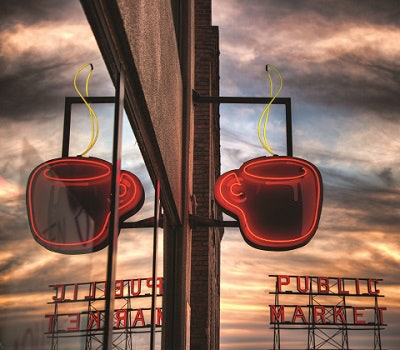
Space for Social Scent
The values listed above can be grouped under today’s broader ideology for pro-social sensitivity and exchange determining creative value. For Harvard Crimson writer Hanaa Masalmeh the significance that “the idea behind ‘let’s grab a cup of coffee’ is not the ‘cup of coffee,’ it’s the let’s” cannot be underestimatedo. There is no reason that it has to be coffee dominating these domains – coffee is being used as a sensory stimulus for a form of “slow joy” in the same way that “slow beauty” argued it reinvented the philosophy of beauty routines by encouraging me-time rituals to promote calm and grounding.
There is currently a gap for slow perfume in the marketplace. Greater moves towards a social-based slow perfume movement could provide new growth areas for the fragrance industry and also spearhead a reimagining of perfume from a predominantly personal statement akin to fashion to an activity and hobby that gets people together and gets them talking. Rather than the perfume itself being considered a creative artifact, perfume could be used as a background, or blackboard, for smellers to generate creative ideas. Could all of these people who are hanging out in coffee shops around the world every day be hanging out in multi-sensory workspaces instead, buying scent prompts (as well as drinks and food) to cocoon on difficult days or aid the process of novel-writing?
Even though niche fragrance operations tried to slow down the perfume sales process, niche shops are still not places you hang around in and sit down for hours. A coffee shop for perfume may sound like an overly simple idea but so did Starbucks in 1971. Need a boost? Bergamot hairspray. Need to relax? Lavender face towel. Want to chat? Rose oil. The conceptual fuel driving sales for pumpkin spice lattes at Christmas and iced americanos in summer is essentially the same as those for scent. Instead of yoga studios selling espressos before morning classes, pump in cardamom through the air system; instead of a mint tea after lunchtime meditation, use incense sticks during the session.
The existence of a fourth wave of coffee culture is contested; yet Dismas Smith, a Seattle-based barista, suggests that “fourth wave could be seen as [an understanding of] coffee’s scientific aspects. We would talk more in-depth about precise knowledge of soil, coffee plants, coffee beans…p” This framework present avenues for perfumery, too. Taking a leaf from coffee shops’ direct sale of sustainable beans, and following on from fragrance consumers’ interest in material origin and DIY blending, imagine a fourth wave of niche perfumery – an olfactory bar, not only selling scent shots and scent-inspired drinks in an informal setting in which customers can sit working, relaxing, and eating for the day, but also offering resins, pastes, herbs and fresh flowers in partnership with florists and foragers for at-home distillation using amateur distillation machines. Strategies like this would reinvigorate a scent industry often disenfranchising for many and could ground a new attitude towards scent uses that culturally repositions it, alongside coffee, as an agent for personal change, available to everyone.


